
Beewolves, also known as bee-hunters or bee-killer wasps, are solitary, predatory wasps, most of which prey on bees, hence their common name. The adult females dig tunnels in the ground for nesting, while the territorial males mark twigs and other objects with pheromones to claim the territory from competing males.

The European beewolf, also known as the bee-killer wasp or the bee-eating philanthus, is a solitary wasp that lives in the Western Palearctic and Afrotropics. Although the adults of the species are herbivores, the species derives its name from the behaviour of the inseminated females, who hunt Western honey bees. The female places several of its paralysed prey together with an egg in a small underground chamber, to serve as food for the wasp larvae. All members of the genus Philanthus hunt various species of bees, but P. triangulum is apparently the only one that specialises in Western honey bees.

Ampulicidae, or cockroach wasps, are a small, primarily tropical family of sphecoid wasps, all of which use various cockroaches as prey for their larvae. They are the most primitive family of sphecoid hunting wasps. They tend to have elongated jaws, pronounced neck-like constrictions behind the head, strongly petiolate abdomens, and deep grooves on the thorax. Many are quite ant-like in appearance, though some are brilliant metallic blue, green, and hot pink.
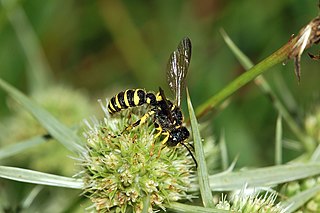
Philanthidae is one of the largest families of wasp in the superfamily Apoidea, with 1167 species in 8 genera, most of which are Cerceris.
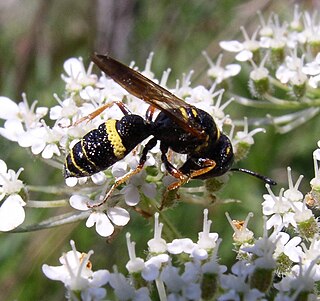
Philanthus gibbosus, the hump-backed beewolf, is a species of bee-hunting wasp and is the most common and widespread member of the genus in North America. P. gibbosus is of the order Hymenoptera and the genus Philanthus. It is native to the Midwestern United States and the western Appalachians. P. gibbosus are often observed to visit flowers and other plants in search of insect prey to feed their young. The prey that P. gibbosus catches is then coated in a layer of pollen and fed to the young wasps.
Philanthus politus is a white-striped species of bee-hunting wasp.
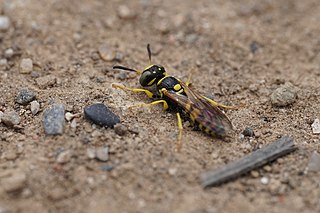
Philanthus pulchellus is a species of bee-hunting wasp of the Iberian Peninsula. Males are territorial and establish territories in nesting areas of females, or in the case of smaller males that are unable to do so, nearby. Females are generalist predators of bees and wasps, including conspecifics, and store the prey in their underground nest.

Philanthus multimaculatus is a species of bee-hunting wasp, or beewolf, found from British Columbia and Alberta south to Zacatecas and San Luis Potosi.
Pacific burrowing wasp can refer to:

Sphex ichneumoneus, known commonly as the great golden digger wasp or great golden sand digger is a wasp in the family Sphecidae. It is identified by the golden pubescence on its head and thorax, its reddish orange legs, and partly reddish orange body. This wasp is native to the Western Hemisphere, from Canada to South America, and provisions its young with various types of paralyzed Orthoptera.
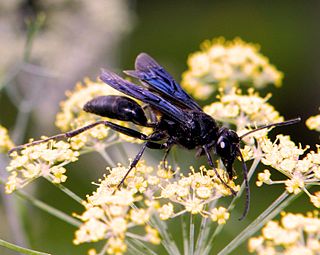
Sphex pensylvanicus, the great black wasp, is a species of digger wasp. It lives across most of North America and grows to a size of 20–35 mm (0.8–1.4 in). The larvae feed on living insects that the females paralyze and carry to the underground nest.
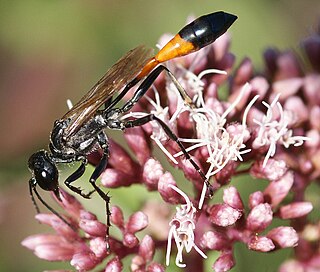
Ammophila sabulosa, the red-banded sand wasp, is a species of the subfamily Ammophilinae of the solitary hunting wasp family Sphecidae, also called digger wasps. Found across Eurasia, the parasitoid wasp is notable for the mass provisioning behaviour of the females, hunting caterpillars mainly on sunny days, paralysing them with a sting, and burying them in a burrow with a single egg. The species is also remarkable for the extent to which females parasitise their own species, either stealing prey from nests of other females to provision their own nests, or in brood parasitism, removing the other female's egg and laying one of her own instead.
The common name digger wasp is a broad term which may refer to any member of the parasitoidal wasp families:
Palmodes is a genus of thread-waisted wasps in the family Sphecidae. There are more than 20 described species in Palmodes.
Philanthus sanbornii is a species of wasp in the family Philanthidae. It is found in North America.

Lestiphorus is a genus of sand wasps in the family Bembicidae. There are about 18 described species in Lestiphorus.
Philanthus solivagus is a species of wasp in the family Philanthidae. It is found in North America.

Philanthus bilunatus is a species of wasp in the family Philanthidae. It is found in North America.
Philanthus lepidus is a species of wasp in the family Philanthidae. It is found in North America. It creates false burrows in its nests, and preys upon Halictidae bees.
P. pacificus may refer to:










